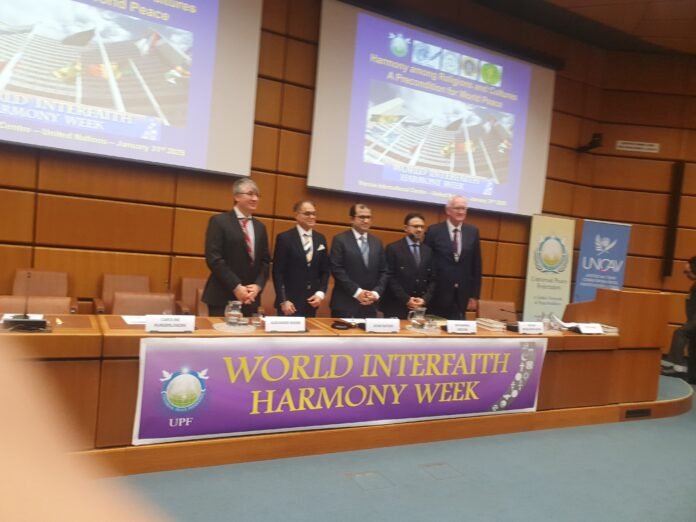Introduction to the Conference
The World Peace Conference, held on January 31, 2025, at the Vienna International Center, served as a crucial platform for dialogue and collaboration among representatives from various backgrounds and religions. This event brought together diplomats, religious leaders, cultural advocates, and peace activists, all united by a common goal: to foster understanding and promote harmony among different religions and cultures. The significance of this conference cannot be understated, as global peace hinges on respect and collaboration between diverse communities.
The discussions centered around the concept that embracing cultural and religious diversity is vital for achieving lasting peace. Participants recognized that, despite varying beliefs and practices, there exists a shared human experience that can unite us in our pursuit of a harmonious existence. Throughout the conference, speakers emphasized that cultivating global harmony requires a commitment to dialogue and mutual respect, and that any sustainable peace initiative must consider the unique perspectives and traditions of all cultures involved.
Additionally, the conference served as a reminder of the challenges humanity faces today, including conflicts fueled by misunderstanding and intolerance. The significance of such an assembly lies in its ability to highlight how collaboration can address these pressing issues. By bringing together a diverse array of voices, the World Peace Conference demonstrated that there is strength in unity, and that peace is attainable when we prioritize understanding over division.
As attendees engaged in vibrant discussions, a collective vision began to emerge— one where shared values and common goals prevail. This event not only emphasized the importance of fostering relationships between cultures and religions, but it also set the stage for ongoing dialogue and initiatives aimed at achieving global harmony in the future.
Distinguished Speakers and Their Contributions
The World Peace Conference in Vienna featured an array of distinguished speakers, each bringing a wealth of experience and a unique perspective on the promotion of peace and interfaith dialogue.
Sessions of Dialogue and Reflection
The World Peace Conference in Vienna comprised two pivotal sessions aimed at fostering dialogue and reflection among participants. The first session, facilitated by esteemed figures in the realm of peace advocacy, concentrated on the foundational elements of peace and cooperation. Recognized leaders and experts from various fields led discussions that underscored the significance of collaborative efforts in resolving conflicts. Emphasizing the necessity for dialogue, this session established frameworks that highlight the importance of mutual respect, understanding, and the underlying similarities across diverse cultures and religions. Participants engaged in thought-provoking dialogues that urged for actionable strategies to cultivate harmony, thereby reinforcing the notion that peace is not merely the absence of conflict but a proactive endeavor requiring commitment from all stakeholders.
In the subsequent session, attendees experienced a vibrant display of cultural expressions through music and art, illustrating the profound role that creative mediums can play in conveying messages of peace. Artists and musicians from different backgrounds showcased their work, demonstrating how the universal language of art transcends barriers. Performances included traditional and contemporary pieces that resonated with themes of unity and reconciliation, captivating the audience and instilling a sense of shared humanity. This segment not only highlighted the therapeutic aspects of art in healing communities but also served as a reminder of the inclusivity necessary for cultivating global harmony. Insights shared during this session emphasized the idea that creative expressions can facilitate dialogue across various faiths and beliefs, reinforcing the call for unity and understanding.
Ultimately, these sessions collectively illustrated how dialogue and cultural expression are instrumental in promoting peace and cooperation among diverse populations. The emphasis on collaboration and the role of art in peace-building efforts set a hopeful tone for future initiatives aimed at addressing global conflicts.
The Vision for Future Peace Initiatives
During the World Peace Conference in Vienna, esteemed delegates gathered to articulate a comprehensive vision for future peace initiatives, reflecting a strong commitment to promoting global harmony. Participants underscored the significance of maintaining ongoing dialogue and cooperation across diverse cultures and faiths. This collective aspiration for dialogue emphasizes the necessity of preserving open channels of communication as a catalyst for understanding and reconciliation.
Key initiatives proposed during the discussions focused on building bridges between communities through intercultural and interfaith collaborations. Participants advocated for educational programs that promote awareness of different cultural histories and traditions, fostering mutual respect and acceptance. Such educational initiatives are viewed as essential in countering prejudices and misconceptions, ultimately paving the way for peaceful coexistence.
In addition to education, delegates discussed the importance of grassroots movements that empower local communities to engage in peacebuilding efforts. These initiatives include community dialogue forums, cultural exchange programs, and collaborative projects aimed at addressing shared challenges. By encouraging active participation at the community level, these programs can help cultivate a sense of shared responsibility toward nurturing peace.
The conference emphasized that sustained efforts are essential for achieving long-term peace and stability. Hence, the commitment to ongoing collaboration among governments, NGOs, and civil society was strongly highlighted. Participants expressed the need for a cohesive framework that facilitates partnerships and resource sharing, allowing for more efficient implementation of peace initiatives on a global scale.
Ultimately, the vision articulated during the World Peace Conference serves as a clear roadmap for future peace efforts. This steadfast dedication to fostering dialogue and cultural exchange reinforces the belief that by working together, communities can build a more peaceful and harmonious world for generations to come.
Speakers:
Dr. Afsar Rathor, former UN Peacekeeping Mission and UNIDO Executive
H.E. Mohammed Sameer Salem Hindawi, Ambassador of the Hashemite Kingdom of Jordan
Bishop Humphrey Sarfaraz Peters, President, Coalition of Faith Based Organizations (FBOs) Pakistan, the former Anglican bishop of Peshawar
Ms. Caroline Hungerländer, Managing director, Institute for Environment, Peace and Development IUFE
Mag. Alexander Rieger, Task Force “Dialog der Kulturen” Ministry for European and International Affairs (tbc)
Prof. Dr. Elmar Kuhn, President, Coalition of FBOs Europe
Dr. Hassan Mohiuddin Qadri, Chairman Supreme Council of Minhaj-ul-Quran International Foundation
Ms. Marlies Ladstätter, coordinator of Youth and Students for Peace Europe
Ms. Tatev Mnatsakanyan, Armenian artist, foto project “Prayer for Peace”
Dr. Androniki Barla, Theologian and Orthodox canon lawyer
Dr. Marie Therese Igrec, Integration of all religions and education of peace in Catholic schools (tbc)
Frequently Asked Questions
Hi there! This post couldn’t be written any better! Reading through this post reminds me of my previous room mate! He always kept talking about this. I will forward this article to him. Pretty sure he will have a good read. Thank you for sharing!


Can I just say what a relief to find someone who really knows what theyre speaking about on the internet. You definitely know tips on how to carry a problem to mild and make it important. More people have to learn this and perceive this side of the story. I cant imagine youre not more common since you undoubtedly have the gift.
I like this site very much, Its a real nice spot to read and incur information.
Definitely believe that which you said. Your favorite reason appeared to be on the internet the easiest thing to be aware of. I say to you, I certainly get irked while people think about worries that they plainly do not know about. You managed to hit the nail upon the top and also defined out the whole thing without having side-effects , people could take a signal. Will likely be back to get more. Thanks
Heya! I just wanted to ask if you ever have any trouble with hackers? My last blog (wordpress) was hacked and I ended up losing a few months of hard work due to no data backup. Do you have any solutions to prevent hackers?
You have brought up a very good points, thanks for the post.
You are a very intelligent person!
I really enjoy reading on this website , it holds excellent articles. “When a man’s willing and eager, the gods join in.” by Aeschylus.
I will right away grab your rss feed as I can’t find your email subscription link or e-newsletter service. Do you have any? Please let me know so that I could subscribe. Thanks.
This is really interesting, You are a very skilled blogger. I’ve joined your rss feed and look forward to seeking more of your magnificent post. Also, I have shared your site in my social networks!
There are some attention-grabbing closing dates in this article however I don’t know if I see all of them center to heart. There’s some validity but I will take maintain opinion until I look into it further. Good article , thanks and we want extra! Added to FeedBurner as well
I will right away snatch your rss feed as I can not find your email subscription hyperlink or e-newsletter service. Do you’ve any? Kindly allow me recognize in order that I could subscribe. Thanks.
Very good blog you have here but I was wanting to know if you knew of any community forums that cover the same topics talked about in this article? I’d really like to be a part of community where I can get feedback from other experienced people that share the same interest. If you have any suggestions, please let me know. Many thanks!
great points altogether, you simply gained a emblem new reader. What might you suggest in regards to your put up that you made some days in the past? Any positive?
Hi there! This post couldn’t be written any better! Reading through this post reminds me of my previous room mate! He always kept talking about this. I will forward this article to him. Pretty sure he will have a good read. Thank you for sharing!